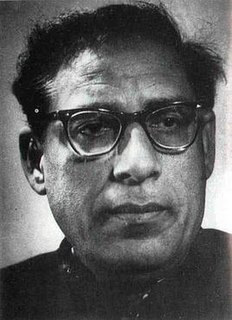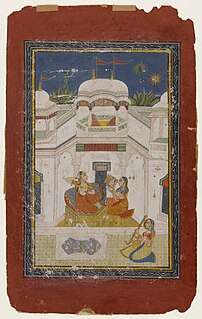Merukhand is an improvisational style in Hindustani classical music involving permutations of a fixed set of swaras or notes (meru, axis or skeleton) broken up in various ways (khand, fragment), while retaining the proper emphasis on various notes as required by the raga.

Hindustani classical music is the traditional music of northern regions of the Indian subcontinent. It may also be called North Indian classical music or Śāstriya Saṅgīt. Its origins date from the 12th century CE, when it diverged from Carnatic music, the classical tradition of southern regions of the Indian subcontinent.

A raga or raag is a melodic framework for improvisation akin to a melodic mode in Indian classical music. While the rāga is a remarkable and central feature of the classical Indian music tradition, it has no direct translation to concepts in the classical European music tradition. Each rāga is an array of melodic structures with musical motifs, considered in the Indian tradition to have the ability to "colour the mind" and affect the emotions of the audience.
Merukhand techniques were developed within the Bhendibazar gharana and popularized by masters like Aman Ali Khan and Abdul Waheed Khan. In the mid-1950s, they were adopted by the eclectic Amir Khan in his own badhat (progression), although he did not use pure merukhand but inserted merukhandi passages into his performance. His disciple Thomas Ross says of this permutational style that
Ustad Aman Ali Khan ‘Amar’ (1888–1953) was an Indian classical vocalist and composer from the Bhendibazaar Gharana. He brought many Carnatic ragas into Hindustani classical music.
Abdul Wahid Khan (1871–1949) was an Indian classical singer, from the Kirana gharana. He died in 1949 in Lahore, Pakistan.

Ustad Amir Khan was an Indian classical vocalist. He is considered one of the most influential figures in Hindustani classical music, and the founder of the Indore gharana.
- improvisational forays treating merely three or four notes may occupy twenty minutes or more. [1]
Merukhand is now a part of the improvisational strategy within the Indore gharana founded by Amir Khan [2]
Indore gharana is one of the vocal gharanas of Indian classical music. It was founded by Amir Khan, who studied the styles of Abdul Wahid Khan, Aman Ali Khan, Rajab Ali Khan and Abdul Karim Khan and amalgamated the essence of the styles of these four maestros with his own intellectual approach to music, and conceived the Indore gharana of music.
"Merukhand" Gayaki In Music Practice Merukhand Gayaki plays a vital role in the frequent practices and even in the performances. Ustad Amir Khan Saheb's Gayaki is always associated with merukhand style, because he often created the raga progressions through this technique, during his recitals, which is why his vocalization was unique and mesmerizing.
In merukhand, 3 or 4 notes patterns are selected and all the possible combinations and patterns are rendered while practices. Merukhand technique works well in enhancing creativity of a singer and in improving the vocalization of jumped notes as well.
To illustrate the merukhand style, let's select 4-note swar pattern initially:
Sa Re Ga Ma
Now we will create all the possible pattern, taking only these notes, without repeating any swaras:
Sa Re Ga Ma Re Sa Ga Ma Ga Re Sa Ma Ma Ga Re Sa Sa Re Ma Ga Re Ga Sa Ma Ga Re Ma Sa Ma Ga Sa Re Sa Ga Re Ma Re Sa Ma Ga Ga Sa Re Ma Ma Re Ga Sa Sa Ga Ma Re Re Ga Ma Sa Ga Sa Ma Re Ma Re Sa Ga Sa Ma Re Ga Re Ma Ga Sa Ga Ma Sa Re Ma Sa Re Ga Sa Ma Ga Re Re Ma Sa Ga Ga Ma Re Sa Ma Sa Ga Re = 24 patterns.
Furthermore, "Pa Dha Ni Sa", "Re Ga Ma Pa" etc. note series also makes 24 possible improvisational patterns. We can see that numerous swar-patterns can be created twisting only four notes.
Specific notes of the ragas can also be practiced for hours, as it keeps the brain engaged in creating phrases. Often, we come to miss some of the patterns. But this is beneficial exercise for amateurs and professionals too. We can take the same pattern to make the Bhairav notes, making Re Komal (flat): Sa Re Ga Ma OR Kafi notes: Sa Re Ga Ma (Ga Komal). , OR Yaman notes: Ni Re Ga Ma (Ma teevra or sharp).
Now we will create the merukhand pattern taking five notes, of Bhoopali raga: S R G P Dh
Sa Re Ga Pa Dha Saa, Saa Dha Pa Ga Re Sa
SRGPD SRGDP SRPGD SRPDG SRDGP SRDPG
SGRPD SGRDP SGPDR SGPRD SGDPR SGDRP
SPRGD SPRDG SPGRD SPGDR SGDRP SGDPR
SDPGR SDPRG SDGRP SDGPR SDRPG SDRGP
RSGPD RSGDP RSPGD RSPDG REDGP RSDPG
GSRPD GSRDP GSPDR GSPRD GSDPR GSDRP
PSRGD PSRDG PSGRD PSGDR PSDRG PSDGR......
There may be more patterns which I have missed out. The idea is that merukhand requires a lot of thinkable and creative brain. As the same time, it takes hours to vocalize each pattern separately with accuracy. For example: SPRDG i.e., Sa-Pa-Re-Dh-Ga pattern looks simple 5 notes, but all these skipped notes might make one crazy during unfolding these tunes.
Initially, merukhand technique requires perseverance, patience and practice, but at last, one can easily be pertinent in improvising the ragas, even in the advanced level. One can attain unhesitating command on rendering taans with absolute variety and fluency, after working on this stylization.



